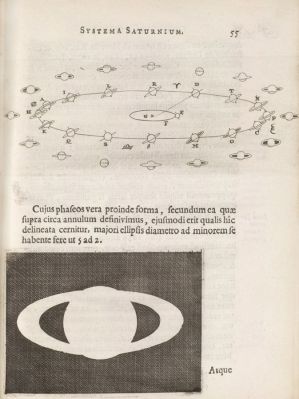[Christiaan Huygens] was a pretty decent mathematician and scientist by the standards of the 17th century. However, the telescopes he built were considered to be relatively poor in quality for the period. Now, as reported by Science News, we may know why. The well-known Huygens may have needed corrective glasses all along.

Huygens is known for, among other things, his contribution to astronomy. He discovered Titan, the largest moon of Saturn, and also studied the planet’s rings. He achieved this despite telescopes that were described at the time as fuzzy or blurrier than they otherwise should have been.
Huygens built two-lens telescopes, and would keep a table of which lenses to combine for different magnification levels. However, his calculations don’t align well with today’s understanding of optics. As it turns out, Huygens may have been nearsighted, which would account for why his telescopes were blurry. To his vision, they may indeed have been sharp, due to the nature of his own eyes. Supporting this are contemporary accounts that suggest Huygens father was nearsighted, with the condition perhaps running in the family. According to calculations by astronomer Alexander Pietrow, Huygens may have had 20/70 vision, in which he could only read at 20 feet what a person with “normal” vision could read from 70 feet away.
It’s a theory that answers a mildly-interesting mystery from many hundreds of years ago. These days, our troubles with telescopes are altogether more complex. If only a simple pair of glasses could solve NASA’s problems!















Much better than your last article, Lewin! Congrats!
Ouch!
I figure at least some of the impressionist painters were nearsighted or had other visions problems and they were just painting exactly what they saw.
Monet had cataracts, which did indeed influence his paintings. After he had the cataracts fixed, he hated many of the paintings for which he is well onown.
https://www.ncbi.nlm.nih.gov/pmc/articles/PMC4408507/
I believe Cassini used Huygens’instruments to “discover” the division in Saturn’s rings. They must not have been too bad.
Cassini may have had the luck of having about the same near-sightedness as Hyghens?
As long as it was Hyghens himself using his scopes, I wouldn’t call them “flawed”, they were “custom made”, and better than a “corrected” scope with eyeglasses of that time would have been.
Makes perfect sense to me, If I was to grind my own telescope lenses I would grind them to suit my eyes
For simple near- or far-sightedness that might work, but it’s generally easier to simply change the distance between the objective and the eyepiece lenses, i.e., focus.
The problems come when one has cylinder, astigmatism, or another error that involves something other than sphericity. For those errors grinding/polishing to shape would be exceedingly difficult. Mostly trial and error. Grind to shape, polish (loooong time!), see how it looks. Not satisfactory? Re-polish, or re-grind AND re-polish… [What’s the emoji for “I’m not having fun anymore… :-)]
I searched for his telescopes and I understood. They were made of two parts connected by a rope, hence fixed focus. Normal telescopes have a focusser that can easily compensate for these problems.
I almost thought “how could someone not know they were near sighted,” then remembered that it took me several years to admit I needed glasses when mine got to 20/100 or so.
It isn’t just a question of “admit.”
You have to recognize that there’s a problem.
I’ve been near sighted all my life. I didn’t know anything was wrong – I thought everything was supposed to be fuzzy.
I found out that I was near sighted when I was thirteen.
My Mom stopped for gasoline, and went to work the pump and fill the tank as usual. She said to only put in ten dollars instead of filling it, so I told my brother to watch the dial and tell me when it got close to $10. Mom asked me why my brother should watch the pump – and I told her I couldn’t read the numbers from that far away.
Bam. Eye doctor, glasses.
It is entirely possible to be very near sighted without realizing it.
Similar story – I went bowling with friends at about 9 years and hated it. Couldn’t see the point – you throw a ball down a lane, and a machine gives you a score. Pure dumb luck. And then I discovered my friends could all see the pins…
A friend reflects that until his parents got him glasses, he didn’t know what phone poles were for.
I recall that I found out I was near-sighted during an annual medical checkup at the age of Fourteen.
The Doctor told my Dad that I should get eyeglasses.
Prior to that time, I had very good vision.
And here we go again, an article intended for a global audience using only units used by 5% of it. Would it be too much effort to consider using proper scientific units in a science article on an engineering-oriented website? 20/70 vision. What’s that? It’d be more useful to know the value in Dioptre, a proper unit.
It turns out 20/70 vision (sorry, do Americans *really* use this as the standard measure for short-sightedness??) is equivalent to -1.25 Dioptre, meaning he could fully focus 1.25metres away. So, not terrible (I’m -5). Brilliant, now we know what power of lens we need to correct for Huygens’ Telescopes: +1.25 Dioptre!
https://www.quora.com/What-are-2-25-and-0-50-converted-to-20-20-for-glasses
There’s more to 20/20 vision than the focus. It is actually about visual acuity, not focus.
https://en.wikipedia.org/wiki/Visual_acuity
You can have a perfectly focused eye but still have 20/70 vision because your retina is damaged or simply has low resolution – or the lens is cloudy (cataracts) like Monet.
Diopter only refers to the power of the lens, not how well you can see.
https://en.wikipedia.org/wiki/Dioptre
Diopters are used in the presciption for corrective lenses – and yes, the US uses dioptres in lens prescriptions.
The visual acuity number is used to diagnose and describe problems with visual acuity.
In France, the scale of vision is on 10 units (so a 10/10 is a perfect (average) vision). I guess you need to convert to us then, but I couldn’t find a calculator online.
It’s a simple ratio that can be expressed as a decimal number regardless of the system, whether it’s 6/6, 10/10 or 20/20. All of those mean 1.0 which is the actual standard way of counting it (EN ISO 8596).
This is because the vision test figures are not defined by their linear size, but by their angular size in your field of vision. A figure twice as large, twice as far, would be equally hard to see – so the charts are simply printed according to whether you’re viewing them from 6 meters or 20 feet.
Ironically, the Dioptre doesn’t belong to the metric system and doesn’t have an official unit.
Diopter are just the reciprocal of the focal length of the lens. Little weird, but it works for optometrists.
As a Canadian, I could go either way. For construction and piping, I think in inches because that is how the products are sized. For everything else, metric. At the plant I work at, temperatures and custodial flow are metric but process flow, differential pressure, gauge pressure and level are generally imperial. To be fair to the author, 20/70 is a ratio and is therefore unitless.
“ Christiaan Huygens] was a pretty decent mathematician and scientist by the standards of the 17th century.”
Seriously? Discovered Titan, came up with the wave theory of light, first theoretical physicist.
Right, but he didn’t have to work, did he? If so, he always had plenty of free time to spend on his convoluted, nebulous ideas. If you lock yourself into a room just long enough and consume bad foods/drinks, you start to see and hear things, see abstract pictures in your head and make the strangest comparison.
– Okay, just kidding. But really, those people back then lived by a different “beat”. Their abstruse theories could either cost their lifes or they could make them popular among the high society. Back then, for the privileged, having your own backyard scientist/philosopher surely was an attractive choice. He was useful to entertain your friends, among other things.
Sorry for my poor English, also.
What’s also import: Light pollution.
Back then there was no light pollution, the skies were crystal clear and a colourful milkyway could be seen with the bare eye.
No wonder those researchers/star gazers could get away with a cheap telescope and and lots of patience.
We nolonger have that luxury. We need good optics to make out stars those pioneers could see with simple binoculars.
Oh, I thought you were going to say he bought his telescopes from AliExpress.